The MIND Diet: Pros and Cons + Meal Plan and Shopping List
Did you know your diet can be a way to keep your brain sharp? The MIND diet may be the answer.
Table of Contents
ToggleResearch suggests that the MIND diet can help protect your brain health and prevent the progressive worsening of confusion or memory loss. Moreover, it can reduce the risk of developing Alzheimer’s. (1)
This article discusses the pros and cons of the MIND diet and provides you with a shopping list and meal plan.
What is the Mind Diet?
MIND stands for Mediterranean-DASH intervention for neurodegenerative delay. DASH is the acronym for dietary approaches to stop hypertension.
The MIND diet was created specifically for brain health and includes foods backed by research to improve brain function and prevent cognitive decline. It’s a combination of the Mediterranean diet and the DASH diet.
This diet emphasizes eating wholesome, natural foods with more specific guidelines to follow than in the a standard Mediterranean-type diet.
While the MIND diet is not a weight loss plan, the pounds might still melt away due to beneficial changes in eating habits.
The Mediterranean Diet
The Mediterranean diet is based on Greek, Italian, and other Mediterranean countries’ traditional cuisines.
So, the Mediterranean diet is high in vegetables, fruits, whole grains, beans, nuts, seeds, and olive oil. Lean meat and wine are also included in this meal pattern, while processed foods are highly discouraged. This style of eating also encourages enjoying meals with friends and family.
This diet is inclusive and delicious, making it easy to follow and, therefore, effective.
The Dash Diet
You might assume that the DASH diet is just a low-sodium diet. However, it isn’t the traditional low-sodium diet. In addition to encouraging the restriction of sodium, it also emphasizes eating foods that are high in calcium, potassium, magnesium, and fiber.
The DASH diet includes vegetables, fruits, whole grains, fat-free or low-fat dairy, fish, poultry, beans, and nuts. This diet aims to limit sodium and foods high in saturated fats.
The MIND diet’s pros and cons are directly related to those of both of these diets.

Mind Diet Pros and Cons
Mind Diet Pros
The MIND diet is beneficial in many ways. The most significant benefit of this diet is that it provides the brain with rich sources of fiber and contains nutrients essential for cognitive function.
MIND Diet and Cognitive Decline
The MIND diet can help protect your ability to learn, focus, and make decisions. In other words, it can help protect against cognitive decline.(2, 3)
What is cognition?
Cognition is all of the brain processes involved in understanding, learning, focusing, remembering, and making judgments. (4) When cognition is compromised, it can affect your brain health, everyday life, and your personality.
Cognitive decline is the progressive worsening of confusion, memory loss, or focus, or a decline in the ability to make judgments. Cognitive decline can range from a mild impairment, like forgetting where you put your phone, to more extreme cases, such as dementia.
The MIND diet protects against cognitive decline even in the absence of Alzheimer’s.
MIND Diet and Alzheimer’s DiseaseMIND Diet and Alzheimer’s Disease
Alzheimer’s is, unfortunately, common among older adults. However, it starts developing much earlier than the golden years, giving you a window of opportunity to protect your brain function before the disease has had a chance to progress.
An interesting study shows that after an average of 4.5 years, people who adhered most closely to the MIND diet had a 53% reduced rate of Alzheimer’s compared to those who did not follow the diet closely.
Links Between MIND Diet Foods and Brain Health
Specific components of the MIND diet are linked to brain health.
For example, a recent study found that mice fed a diet high in salt had higher levels of tau, a protein found in the brains of people with Alzheimer’s. (5)
Another example is the research suggesting that a daily serving of leafy green vegetables is associated with slower cognitive decline.(6)
Blueberries are another great example of foods included in the MIND diet to protect your brain health. Blueberries are rich in nutrients (called polyphenols) that are known to benefit cognitive performance and mood. (7)
In my expert opinion, while we still need more research, there is no doubt that the MIND diet is healthy and sustainable. The MIND diet can protect your brain health but will do much more than that – it will protect your overall health.
Mind Diet Cons
There are no disadvantages to this diet. However, it’s good to keep in mind that other elements of a healthy lifestyle are also necessary for brain health, such as a good night’s sleep and regular physical activity.
MIND Diet Principles
10 Foods to Include
- Eat green leafy vegetables most days, such as kale, arugula, spinach, and collard greens.
- Include fresh vegetables every day (two servings or more). If fresh vegetables are not available, frozen vegetables are a good choice.
- Eat berries at least two times per week.
- Snack on nuts or add nuts or seeds to your meals at least five days a week.
- Enjoy olive oil daily.
- Eat at least three servings of whole grains per day.
- Eat fish every week. Choose fatty fish such as salmon, mackerel, herring, and sardines often.
- Include lean proteins such as poultry at least twice per week.
- Include legumes like beans, garbanzo, and lentils at least three times a week.
- Drink wine in moderation (one glass a day).
5 Foods to Limit or Avoid
- Butter and margarine. Use healthier fats such as olive oil or ghee more often and limit or avoid butter and margarine.
- Cheese. Limit to one slice a week.
- Fried foods. Try using an air fryer as a way to enjoy your favorite fried foods.
- Sweets and pastries. Limit eating sweets to a few times a week. If you have a sweet tooth, choose healthier versions of your favorite foods or just eat them less often and in small quantities.
- Red meat. Limit to one time a week.

MIND Diet Shopping List
Click here for a PDF version of the MIND diet shopping list
| Food Type | Foods to Eat | Tips |
| Fish/seafood | Fatty fish like salmon, tuna, herring, mackerel are preferred, but all types of fish are a good choice. All seafood. | Avoid or limit fried and salted fish and seafood. |
| Poultry | Chicken, turkey, eggs. | Avoid or limit fried chicken and turkey. |
| Legumes | Beans, lentils, chickpeas, and all types of legumes. | If you buy legumes in cans, rinse them in water before using them. |
| Vegetables | Green leafy vegetables. All fresh or frozen vegetables. | Limit canned vegetables, fried vegetables, or vegetables cooked with large amounts of fat. |
| Fruit | Berries. All fresh and frozen fruits. | Avoid canned fruits packed in syrup. Limit fruit juice. |
| Nuts and seeds | Flaxseeds, walnuts, almonds, hazelnuts, pistachios, Brazil nuts, cashews, peanuts, sunflower, and sesame seeds. Nut butter such as almond and peanut butter. | Avoid salted nuts. Nut butter: look for natural versions and avoid those with added sugar. |
| Whole grains | Oats, whole wheat pasta, farro, millet, quinoa, buckwheat, brown rice, whole wheat bread, and other whole grains. | Limit white rice, white pasta, and anything without fiber. |
| Healthy fats | Olive oil | Limit butter and avoid margarine. |
| Herbs and Spices | Cinnamon, nutmeg, turmeric, ginger, garlic, cayenne, black pepper, basil, oregano, cumin, thyme, clove, and cinnamon. | Limit spices with salt. |
| Treats | Dark chocolate. | Limit all sweets and pastries. |
5 Day Sample Meal Plan
Monday
- Breakfast: Greek yogurt with blueberries, topped with walnuts.
- Lunch: Whole wheat chicken breast sandwich, no mayo. Add flavor by using dijon mustard. Serve with a piece of fruit.
- Dinner: Quinoa, fish, and vegetable bowl.
Tuesday
- Breakfast: Whole wheat toast with avocado, arugula, sliced hard-boiled egg.
- Lunch: Greek salad topped with grilled chicken.
- Dinner: Whole wheat pasta with vegetables, tomato sauce, and a small amount of your favorite cheese (one ounce).
Wednesday
- Breakfast: Overnight oats with strawberries and your favorite nuts.
- Lunch: Green salad (use spinach or arugula) topped with shrimp or fish. Use olive oil and vinegar as dressing. Serve with whole wheat crackers or add a whole grain like farro to the salad.
- Dinner: One pan chicken, sweet potatoes, and veggies.
Thursday
- Breakfast: Scrambled eggs with your favorite vegetables and whole wheat bread.
- Lunch: Vegetable soup, grilled chicken, and whole wheat crackers.
- Dinner: Shrimp shish kebabs served with couscous.
Friday
- Breakfast: Oatmeal cooked with apples. Add nuts on top.
- Lunch: Salad with roasted veggies and grilled salmon.
- Dinner: Baked chicken breast, rice, beans, and salad (use olive oil and lime as dressing)
Conclusion
Even though research is growing surrounding the MIND diet, the research that has been complete shows promising results regarding dietary interventions for cognitive decline. Could eating this way early in life help you reduce your chances of developing dementia or Alzheimer’s? It might be a great diet to implement since the chances are high!
After reviewing the MIND diet’s pros and cons, our expert opinion is that the MIND diet is good for brain health and great for your overall health. Plus, this diet is delicious and easy to follow.
“The Mind Diet Pros and Cons” was written by Su-Nui Escobar, DCN, RDN, FAND, in collaboration with Registered Dietitian Meagan Murphy.

Dr. Su-Nui Escobar, a Registered Dietitian/Nutritionist in Miami, FL, is dedicated to empowering women in perimenopause and menopause to live healthier, more satisfying lives.
With a doctorate in clinical nutrition from the University of North Florida, she has expertise in menopause and weight loss, including the unique challenges faced by those on weight loss medications.
Su-Nui’s passion for her field is evident in her previous role as the Academy of Nutrition and Dietetics spokesperson.


